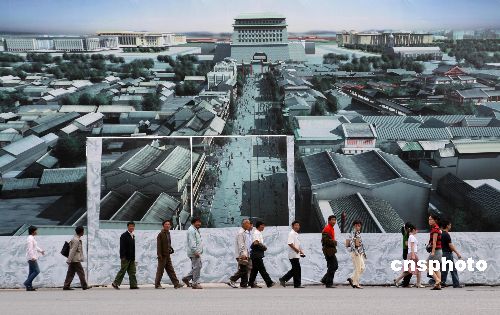Beijng's Qianmen Street: A revival of old dreams
时间:2007-05-23 07:19:11
(单词翻译:单击)

| People walk in front of a huge picture of the Qianmen Street planning project at a construction site in Beijing May 21, 2007. |
| May 22 - Beijing's Qianmen Street, which is currently under redevelopment, will restore its streetscape to that of the early twentieth century, through use of historical photos, becoming the second pedestrian thoroughfare in the Chinese capital, after Wangfujing Street, the downtown shopping district.
China News Service reports that the new Qianmen Street will not be modeled after its state in the Ming and Qing Dynasties (1368-1911), as its designers had anticipated, but into the form of the old Qianmen Street in 1920s-1930s, a time period that left numerous historical photos - by which architects can study in forming the new street. Wang Shiren, a chief designer of the new Qianmen Street and a renowned1 architect, said the final plan was achieved through a series of studies, discussions and revisions. "The Ming and Qing Dynasties' Qianmen Street was burnt down to ashes in 1900 when the Allied2 Forces of the Eight Powers ransacked3 Beijing. Physically4, there is nothing left for us to retrieve5. The final plan is based on historical photos, and we intend to form a new Qianmen Street in the mould of the 1920s to 1930s." After redevelopment, the new Qianmen Street will stretch from the southern end of Tian'anmen Square to the Zhushikou Street, measuring 845m in length. A trolley6 car, familiar to Beijing's senior citizens, will return to the street and become the only transportation vehicle on the pedestrian thoroughfare. An underground parking lot will also be built to tackle the problem of parking spaces in the Qianmen area. Time-honored shops in the area, Qianmen Street's business card, will receive the greatest amount of protection. With its latticework of horizontal alleys7, the north-south Qianmen Street prospered8 as a commercial strip as early as the Yuan Dynasty (1206-1368). By the time of Emperor Jiajing, the 12th Ming Dynasty (1368-1644) emperor, the street was dotted with guild9 halls built by different localities, to provide housing to citizens intending to take the imperial exams. Qianmen Street became even more prosperous in the early years of the Qing Dynasty (1644-1911) with the development of activities such as lantern fairs, theaters and teahouses. Places like the Guanghe Theater -- today threatened with demolition10 -- and the Quanjude roast duck restaurant are part of Beijing's history. The massive redevelopment of Qianmen Street, which began in late 2002, is part of Beijing's efforts to refurbish old city areas ahead of the 2008 Olympic Games. |
点击 收听单词发音
收听单词发音
 收听单词发音
收听单词发音
1
renowned

|
|
| adj.著名的,有名望的,声誉鹊起的 | |
参考例句: |
|
|
|
2
allied

|
|
| adj.协约国的;同盟国的 | |
参考例句: |
|
|
|
3
ransacked

|
|
| v.彻底搜查( ransack的过去式和过去分词 );抢劫,掠夺 | |
参考例句: |
|
|
|
4
physically

|
|
| adj.物质上,体格上,身体上,按自然规律 | |
参考例句: |
|
|
|
5
retrieve

|
|
| vt.重新得到,收回;挽回,补救;检索 | |
参考例句: |
|
|
|
6
trolley

|
|
| n.手推车,台车;无轨电车;有轨电车 | |
参考例句: |
|
|
|
7
alleys

|
|
| 胡同,小巷( alley的名词复数 ); 小径 | |
参考例句: |
|
|
|
8
prospered

|
|
| 成功,兴旺( prosper的过去式和过去分词 ) | |
参考例句: |
|
|
|
9
guild

|
|
| n.行会,同业公会,协会 | |
参考例句: |
|
|
|
10
demolition

|
|
| n.破坏,毁坏,毁坏之遗迹 | |
参考例句: |
|
|
|
©2005-2010英文阅读网




